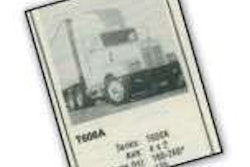UNDERSTANDING financial ratios

By now, you have developed a solid basic understanding of financial statements. Now it’s time to learn what sophisticated readers do with these numbers. Bankers, accountants, credit analysts, financial officers and potential buyers pull certain numbers out of the financial reports and perform mathematical calculations, called financial ratios, to measure your company’s health.
Your own personal health, as measured by your annual physical exam, is a good model for how this works. After your lab work comes back, your doctor examines your blood test results and discusses them with you. He might say your cholesterol count is 185, which by itself means nothing to you, and you have no idea how the lab arrived at that figure. If the doctor says that you generally are healthy as long as the number stays below 200, you relax. But if he says that over the last four years it’s climbed steadily from 140, then you need to explore ways of reducing the number.
Financial ratios and analyses are no different. You don’t have to be an expert at the computation, but you should know what the ratios say about your company’s financial health. Also, lenders almost always have loan covenants that dictate the minimum ratios the company must achieve. Financial ratios help you compare current results with your company’s trends over time and with the current results of others.
By examining the same ratio over time, you can determine whether the company is getting stronger or weaker in the area the ratio measures. Similarly, you can compare your profit margin to that of another company or to industry averages. Using ratios this way helps analysts make sense of pure dollar amounts, which can be confusing when comparing companies having different revenues or assets.
Owners or managers who don’t have financial backgrounds might not realize that they already use ratios in their companies. If you’ve ever signed for a business loan, you likely agreed to keep the financial condition of your company within certain bounds. These affirmative covenants appear in the loan agreement as minimum financial ratios. Is your company in compliance? You won’t know unless someone in your company regularly computes the ratios. There are dozens of financial ratios, but they commonly fall into major groupings.
Liquidity ratios measure the company’s working capital and how it is managed. It takes money to make money. Has the company invested enough to keep operating? How financially liquid or flexible is the company?
Working capital is that part of the company’s current assets needed to keep its doors open: cash in the bank, plus receivables and other current assets, minus amounts borrowed from creditors for short-term needs. These may include lines of credit; payables due suppliers, drivers and employees; and for taxes. Although employees expect to be paid as often as weekly and vendors at least monthly, your customers might take 45 to 60 or more days to pay. That’s why you need more current assets than current liabilities. In other words, you need working capital.
Suppose your current assets total $1 million and your current liabilities total $750,000. That leaves net working capital of $250,000. Without working capital, you will spend so much time making ends meet and answering calls from creditors that sales, operations and profits will suffer.
Current ratios are current assets divided by current liabilities. In our example, $1 million divided by $750,000 produces a current ratio of 1.33 to 1. The minimum healthy range for current ratios in the trucking industry is at least 1.1 to 1 or better.
Profitability ratios are measurements drawn primarily from the P&L. Strong sales are important, but more important is maintaining the margins as you grow your company’s revenues.
Operating ratio, known as “OR,” is a basic and widely used measure of cost efficiency. It is calculated as a company’s total operating expenses, less interest and income taxes, expressed as a percentage of total company revenues. This is not to be confused with “operating margin.” Suppose your company’s total revenue was $1 million and that your total expenses were $1 million, including interest of $30,000 and income taxes of $10,000. To compute operating ratio, subtract interest and taxes, leaving $960,000. Divide $960,000 into $1 million, and your resulting operating ratio is 96 percent. Obviously, the lower your operating ratio, the better. Typically, an operating ratio below 95 percent is considered good, and outstanding companies often post ORs in the 80s.
Operating profit margin is operating profit divided by total revenues earned and is expressed as a percentage. This is generally income before interest expense or taxes. Four to six percent is considered average, and the most profitable companies may have eight percent or more.
Pre-tax net is income before tax divided by revenues. Three to four percent is average for trucking companies; the most profitable are above five or six percent.
Return on equity is computed by dividing after-tax net income by average equity from the balance sheet. If your company earned $150,000 after tax on average equity of $900,000, you earned almost 17 percent return on equity. Evaluate this number against what other investments earn.
Efficiency or activity ratios measure management’s effectiveness in certain business activities. The most common is average days outstanding for accounts receivable or DSO (Days Sales Outstanding), computed by dividing receivables by average daily revenues. If annual revenue is $7 million, each day averages $19,200 in revenue. If receivables total $850,000, the average receivable is outstanding 44 days ($850,000 divided by $19,200) from end of haul to payment — about industry average. If a company’s ratio is 60, then someone needs to get busy collecting. A similar ratio can be computed for vendor payables, with most averaging 30 days or less.
DSO computations can go much deeper than a simple financial calculation. More sophisticated trucking companies start counting DSO from the time the truck is dispatched to the time the check is deposited into the bank. The masters of DSO do everything operationally possible to reduce this number. These guys want their cash! Refer to the CCU book “How to Manage Cash Flow” to see how to reduce DSO. n











